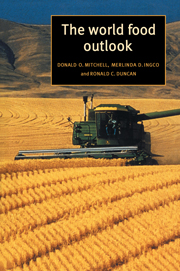Book contents
- Frontmatter
- Contents
- List of figures
- List of tables
- Preface
- List of abbreviations
- 1 The world food problem
- 2 The price of food
- 3 Gains in consumption levels
- 4 World food production increases
- 5 Population growth and food demand
- 6 The quantity and quality of the resource base
- 7 Raising yields
- 8 Changing consumption patterns
- 9 Simulating the future world food situation
- 10 The world can feed twice as many in twenty years
- 11 A robust prediction?
- 12 Africa presents a special challenge at the turn of the century
- Appendix The World Grains Model
- References
- Index
9 - Simulating the future world food situation
Published online by Cambridge University Press: 06 November 2009
- Frontmatter
- Contents
- List of figures
- List of tables
- Preface
- List of abbreviations
- 1 The world food problem
- 2 The price of food
- 3 Gains in consumption levels
- 4 World food production increases
- 5 Population growth and food demand
- 6 The quantity and quality of the resource base
- 7 Raising yields
- 8 Changing consumption patterns
- 9 Simulating the future world food situation
- 10 The world can feed twice as many in twenty years
- 11 A robust prediction?
- 12 Africa presents a special challenge at the turn of the century
- Appendix The World Grains Model
- References
- Index
Summary
In order to evaluate whether the dramatic changes in the world food situation experienced since the 1960s are likely to continue, an econometric model of the world cereals markets is simulated to the year 2010. An initial set of assumptions for key variables basically defines the ‘best estimate’ for the future. These assumptions are used to produce a baseline simulation. Alternative assumptions are then introduced to test the sensitivity of the projected world food situation to changes in the original assumptions. The most important variables are
Population. The world population growth rate is projected to slow over the next fifteen years from about 1.7 per cent per annum in 1992 to about 1.4 per cent per annum in 2010. If this occurs, it will assist in the task of feeding the world. If population grows at a faster rate, more investment, particularly in research, would be required to increase crop yields.
Cereals yields. Yields have accounted for 90 per cent of the increase in cereals production since 1950. If yields continue to grow at the same rate as in the 1980s – 2.5 per cent per annum – then meeting projected food demand increases will be achieved comfortably. Even slower yield growth may be adequate if population growth slows as projected.
Reforms in the former centrally planned economies. The former centrally planned economies of Eastern Europe and the Soviet Union could represent a safety valve for the world food system. Because of distorted prices and centrally controlled decision-making, food production in these economies stagnated during the 1970s and 1980s while consumption accelerated. This led to the region becoming a large food importer.
[…]
- Type
- Chapter
- Information
- The World Food Outlook , pp. 106 - 119Publisher: Cambridge University PressPrint publication year: 1997



